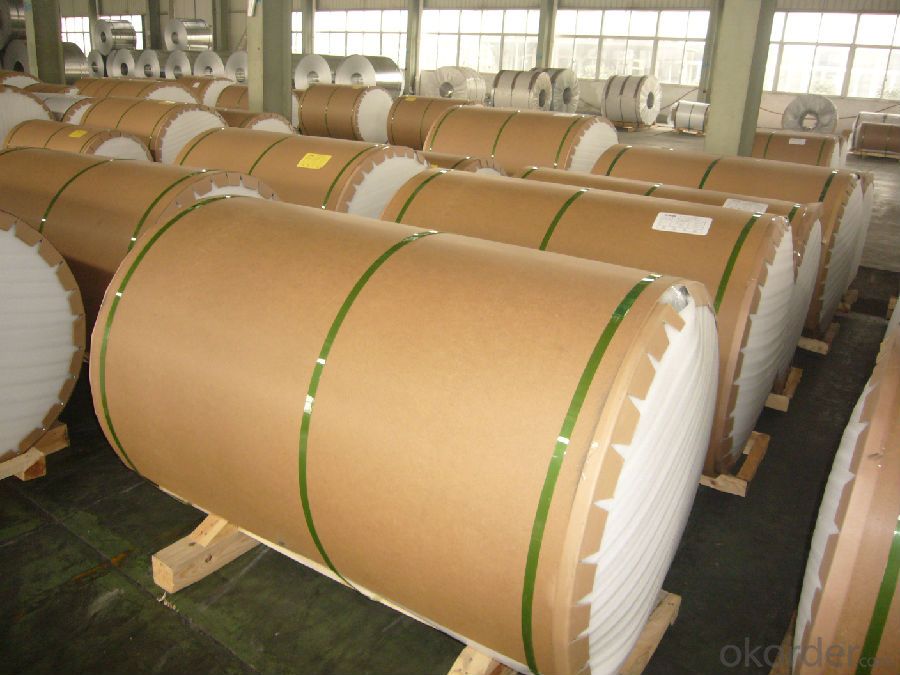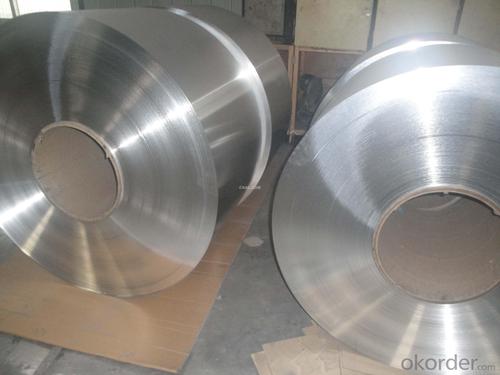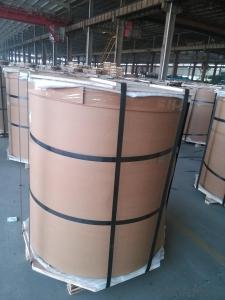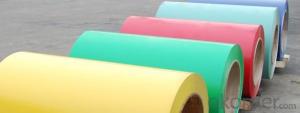Aluminum Coils Inc Tampa - D.C AA3005 Aluminum Coils Used as Building Material
- Loading Port:
- Shanghai
- Payment Terms:
- TT OR LC
- Min Order Qty:
- 5 m.t.
- Supply Capability:
- 10000 m.t./month
OKorder Service Pledge
OKorder Financial Service
You Might Also Like
Specification
1.Structure of D.C AA3005 Aluminum Coils used as Building Material Description
D.C AA3005 Aluminum Coils used as Building Material widly used in decoration field. For the painting, it depends on the using evironment. If you use in the open air, we recommend the PVDF coated aluminium coils. This kind of painting can last 15-20 years. If you use in the room, we recommend PE coated aluminium coils. The price is much more competitive.
Direct Continuous Aluminium Foil Stock in Coil is one semi-finished aluminium material. This strip can be rolled down to aluminium foil.The final thickess can be 5-20 microns. Aluminium foil is soft, ductile and with a silver-white luster which can be widely used in a large scare of fields.
2.Main Features of D.C AA3005 Aluminum Coils used as Building Material
a.Competitive price---We have our own mills and can produce mill finished aluminium coils, so we can control the production cost better.
b.Professional after-sale service---We have more than 15 years exportation experience and you need not worry about the exporation problems.
c.Fast delivery time---We can control the delivery time within 35 days.
3.D.C AA3005 Aluminum Coils used as Building Material Images



4.D.C AA3005 Aluminum Coils used as Building Material Specification
Alloy | AA3005 |
Temper | H14, H16, H18, H22, H24, H26, H32, O/F |
Thickness | 0.2mm -- 100mm |
Width | 30mm -- 1700mm |
Standard | GB/T 3880-2006,EN |
5. FAQ of D.C AA3005 Aluminum Coils used as Building Material
A.How to guarantee the quality?
Customers are welcome to our mill to visit and check the products. Besides, we can arrange a third party to test D.C AA3005 Aluminum Coils used as Building Material.
B.When will you deliver the products?
D.C AA3005 Aluminum Coils used as Building Material will be delivered within 35 days after receiving advanced payment or original L/C.
- Q: This question asks for methods to determine the age of an aluminum coil, distinguishing between new and old.
- <p>To determine if an aluminum coil is new or old, you can look for several indicators: the surface condition, such as scratches or signs of wear; the quality of the protective coating, if any, which may degrade over time; the manufacturing date or batch number, if available; and the overall appearance and shine. New coils typically have a smooth, shiny surface with no significant scratches or dents, and a consistent protective coating. Old coils may show signs of oxidation, discoloration, or other forms of degradation. Additionally, testing the coil's physical properties, such as tensile strength, can provide clues about its age, as these properties can degrade over time.</p>
- Q: I need to draw dot and cross diagrams to explain how they bond, but if the aluminium outer shell has 13 electrons and the oxygen one has 6, how do they all become happy atoms, and all have a full outer shell? please help! thank you.
- I really do not know so ask somebody else
- Q: im doing this essay in my chemistry class that suppose to be a ficional story about the day my element, aluminum, slowly began disappearing.i know some things that will happen like no soda cans of anything of that, no foil no forks or spoons anything metally. i need more effects that will happen but my major problem is how to start this. i have no clue like how to begin.can anyone help pleased.!
- okorder
- Q: What is the maximum coil diameter for aluminum coils?
- The maximum coil diameter for aluminum coils can vary depending on the specific application and manufacturing process. However, in general, the maximum coil diameter for aluminum coils typically ranges from 60 inches (152.4 cm) to 120 inches (304.8 cm). This diameter limit is determined by factors such as the size of the production equipment, the thickness and width of the aluminum sheet being processed, and the handling capabilities of the facility. It is important to consult with the manufacturer or supplier to determine the specific maximum coil diameter for a particular aluminum coil product.
- Q: Are aluminum coils suitable for coil winding applications?
- Yes, aluminum coils are suitable for coil winding applications. Aluminum has excellent electrical conductivity, high thermal conductivity, and good corrosion resistance, making it a suitable material for various coil winding applications, including transformers, motors, generators, and inductors. Additionally, aluminum coils are lightweight, which can provide advantages in terms of transportation and handling.
- Q: How are aluminum coils protected against oxidation?
- Aluminum coil coating is a process that safeguards aluminum coils from oxidation. It entails the application of a protective coating or layer onto the coil's surface to prevent direct contact with oxygen and other environmental factors that may induce oxidation. Acting as a barrier, this protective coating shields the aluminum from moisture, air, and other corrosive substances. Multiple types of coatings are utilized to protect aluminum coils. One common method involves applying a clear or colored organic coating, such as polyester or polyvinylidene fluoride (PVDF). These coatings not only create a barrier against oxidation but also enhance the coils' durability and aesthetic appeal. Another approach is anodizing, which immerses the aluminum coil in an electrolytic solution and passes an electric current through it. This process forms a layer of aluminum oxide on the coil's surface, serving as a natural protective barrier against oxidation. Anodized aluminum coils are renowned for their exceptional corrosion resistance and can be further improved with additional coating layers. Furthermore, chemical conversion coatings can be employed to protect aluminum coils. These coatings, such as chromate or phosphoric acid-based coatings, chemically react with the aluminum surface, generating a protective layer that prevents oxidation. In summary, safeguarding aluminum coils against oxidation is crucial for their longevity and performance. Through the application of various coatings, anodizing, or chemical conversion processes, the coils can effectively resist oxidation and maintain their integrity even in harsh environments.
- Q: Can aluminum coils be utilized as an insulating material?
- <p>Aluminum coils are not typically used for insulation. They are good conductors of heat and electricity, which makes them unsuitable for insulation purposes. Insulation materials should be poor conductors to prevent the flow of heat or electricity. Aluminum coils are more commonly used in applications where conductivity is desired, such as in electrical wiring or heat exchangers. For insulation, materials like fiberglass, mineral wool, or plastic foams are used because they resist heat flow effectively.</p>
- Q: I'm 14 an was told that aluminum free deodorant would stop yellow stains on my white shirts, so which female deodorant would help stop yellow stains
- Aluminum salts are used in antiperspirants. So, skip anything that claims to be an antiperspirant. (Some things that are antiperspirants are sold as deodorants, but not the other way around.) Right Guard Sport spray does not contain aluminum salts, and my T-shirts stayed white after I switched to it. Many people mistakenly think that it is the sweat that discolors the armpits.
- Q: Can aluminum coils be used for window frames?
- Certainly, window frames can indeed be made using aluminum coils. Aluminum is widely favored for window frames owing to its enduring nature, lightweight composition, and ability to resist corrosion. It is extensively employed in both residential and commercial settings. Aluminum coils can be effortlessly molded and adjusted to accommodate diverse window dimensions and designs. Additionally, aluminum frames provide exceptional thermal insulation qualities, thereby enhancing energy efficiency in structures. All in all, aluminum coils represent a dependable and pragmatic choice for constructing window frames.
- Q: What is the role of aluminum coils in the construction of aircraft?
- The role of aluminum coils in the construction of aircraft is crucial and multifaceted. Aluminum is the preferred material for manufacturing aircraft due to its exceptional properties such as lightweight, durability, and corrosion resistance. Aluminum coils, specifically, are used extensively in various parts of an aircraft, including the fuselage, wings, and structural components. One of the primary functions of aluminum coils is to provide structural strength while maintaining a lightweight design. By using aluminum coils, aircraft manufacturers can reduce the overall weight of the aircraft, leading to improved fuel efficiency and increased payload capacity. This is especially important in aviation, where every ounce of weight reduction can have a significant impact on performance and operational costs. Additionally, aluminum coils play a crucial role in the aerodynamic design of an aircraft. These coils are used to shape the wings and other aerodynamic surfaces, allowing for better airflow and reduced drag. The flexibility of aluminum coils enables engineers to create complex, curved shapes that optimize the aircraft's aerodynamic performance, resulting in improved maneuverability and reduced fuel consumption. Another vital aspect of aluminum coils in aircraft construction is their corrosion resistance. Aluminum naturally forms a protective oxide layer when exposed to air, making it highly resistant to corrosion. This property is essential in ensuring the longevity and structural integrity of the aircraft, particularly when exposed to harsh environmental conditions, such as high-altitude or coastal regions. Furthermore, aluminum coils are used in the fabrication of heat exchangers, which are crucial components in the aircraft's cooling and ventilation systems. These coils efficiently transfer heat either to or from the air, depending on the system's requirements, allowing for effective temperature control within the aircraft's cabin and engine compartments. In conclusion, the role of aluminum coils in the construction of aircraft is indispensable. They provide structural strength, contribute to aerodynamic efficiency, offer corrosion resistance, and facilitate efficient heat exchange. The utilization of aluminum coils allows for the development of high-performance, reliable, and fuel-efficient aircraft essential for modern aviation.
Send your message to us
Aluminum Coils Inc Tampa - D.C AA3005 Aluminum Coils Used as Building Material
- Loading Port:
- Shanghai
- Payment Terms:
- TT OR LC
- Min Order Qty:
- 5 m.t.
- Supply Capability:
- 10000 m.t./month
OKorder Service Pledge
OKorder Financial Service
Similar products
Hot products
Hot Searches
Related keywords



























